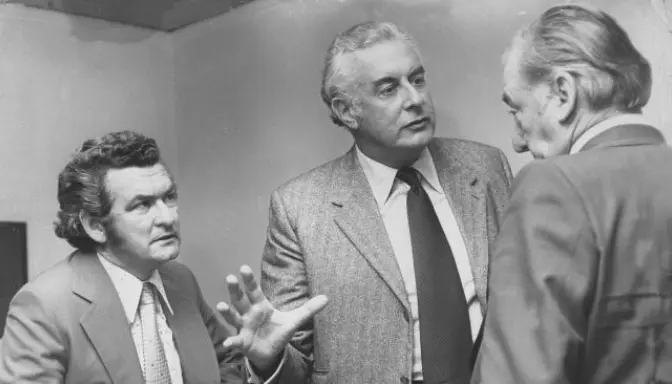Diksia.com - The loans affair, also known as the Khemlani affair, was a political scandal that rocked the Whitlam government of Australia in 1975. It involved the government’s attempt to borrow billions of dollars from the Middle East through a shady Pakistani banker, Tirath Khemlani, without following the proper procedures and constitutional requirements. The affair exposed the government to allegations of corruption, incompetence, and deception, and contributed to its downfall in the 1975 constitutional crisis.
Background: The Whitlam Government and Its Ambitious Plans
The Whitlam government came to power in 1972, ending 23 years of conservative rule by the Liberal-Country Party coalition. Led by Prime Minister Gough Whitlam, the Labor Party promised a bold and progressive agenda of social, economic, and cultural reforms. Some of the achievements of the Whitlam government included the establishment of universal health care (Medibank), the abolition of university fees, the recognition of Aboriginal land rights, the withdrawal of Australian troops from Vietnam, the adoption of a new national anthem (Advance Australia Fair), and the promotion of a more independent foreign policy.
One of the key ministers in the Whitlam cabinet was Rex Connor, the Minister for Minerals and Energy. Connor had a grand vision of developing Australia’s vast natural resources and securing Australian ownership and control over them. He believed that Australia could become a major player in the global energy market and use its mineral wealth to fund its social programs and infrastructure projects. To achieve his goals, Connor needed a massive amount of capital, which he sought to obtain from overseas loans.
The Khemlani Connection: A Risky and Secretive Deal
In late 1974, Connor was introduced to Tirath Khemlani, a London-based commodities trader who claimed to have access to large sums of money from Middle Eastern sources. Khemlani offered to arrange loans for the Australian government at favorable terms and with a generous commission for himself. Connor was impressed by Khemlani’s credentials and agreed to pursue the deal.
However, there were several problems with the Khemlani connection. First, the size of the loan was enormous: Connor initially sought US$4 billion, which was later reduced to US$2 billion, but still equivalent to about 25% of Australia’s gross domestic product at the time. Second, the source of the loan was dubious: Khemlani was not a reputable banker, but a shady middleman who had no guarantee of delivering the funds.
Third, the process of the loan was irregular: Connor bypassed the standard procedures of the Australian Treasury and the Loan Council, which were responsible for overseeing government borrowings. He also obtained the approval of the Federal Executive Council, a subset of the cabinet, without informing the Governor-General, Sir John Kerr, who was the representative of the Queen and the head of state. Moreover, Connor kept the loan deal secret from the public and the parliament, and misled them about its nature and progress.
The Scandal Breaks: A Series of Revelations and Resignations
The loans affair came to light in May 1975, when the opposition leader, Malcolm Fraser, questioned the government about its overseas borrowings in parliament. Fraser had received a tip-off from a journalist, who had been contacted by Khemlani, who was frustrated by Connor’s delays and demands. The government initially denied any wrongdoing, but soon admitted that Connor had been authorized to seek loans for “temporary purposes”. This was a dubious claim, as the loans were clearly intended for long-term projects, and violated the constitutional requirement that non-temporary borrowings be approved by the Loan Council, which included representatives of the state governments.
The government then revoked Connor’s authority to seek loans on 20 May 1975, and held a special parliamentary session on 9 July 1975 to explain the affair. However, the explanations were unsatisfactory and contradictory, and the opposition accused the government of lying and covering up. The scandal worsened in October 1975, when the Melbourne Herald published a series of telexes that showed that Connor had continued to negotiate with Khemlani after his authority had been withdrawn. Connor resigned on 14 October 1975, admitting that he had made a “grave error of judgment”.
Connor was not the only minister who was implicated in the loans affair. Jim Cairns, the Deputy Prime Minister and Treasurer, had also been involved in a separate loan deal with a Melbourne businessman, George Harris, who had offered to secure funds for the government. Cairns had signed a letter in March 1975, agreeing to pay Harris a 2.5% commission, which he later denied in parliament. When the letter was revealed in July 1975, Cairns was sacked by Whitlam.
The Aftermath: The Constitutional Crisis and the Dismissal of the Government
The loans affair damaged the credibility and popularity of the Whitlam government, and gave the opposition a pretext to block its budget bills in the Senate, where it had a majority. The opposition hoped to force the government to call an early election, or to persuade the Governor-General to dismiss the government and appoint an interim administration. The government refused to yield, and a constitutional deadlock ensued.
The crisis reached its climax on 11 November 1975, when Kerr dismissed Whitlam and appointed Fraser as the caretaker Prime Minister, pending a double dissolution election. This was a controversial and unprecedented move, as it was the first and only time that the Governor-General had exercised his reserve powers to dismiss an elected government. The dismissal sparked a public outcry and a constitutional debate that continues to this day.
The election was held on 13 December 1975, and resulted in a landslide victory for the Fraser-led coalition, which won 91 seats out of 127 in the House of Representatives, and 35 seats out of 64 in the Senate. The Whitlam government was decisively defeated, and its reform agenda was largely dismantled by the Fraser government. The loans affair was one of the main factors that contributed to the downfall of the Whitlam government, and marked a turning point in Australian political history.
Conclusion
The loans affair was a political scandal that involved the Whitlam government’s attempt to borrow billions of dollars from the Middle East through a dubious Pakistani banker, Tirath Khemlani, without following the proper procedures and constitutional requirements. The affair exposed the government to allegations of corruption, incompetence, and deception, and contributed to its downfall in the 1975 constitutional crisis, which resulted in the dismissal of the government by the Governor-General, Sir John Kerr, and the election of the Fraser-led coalition. The loans affair was a major political and constitutional drama that shook Australia and had lasting implications for its democracy and governance.






